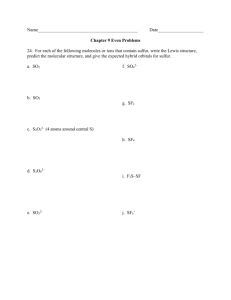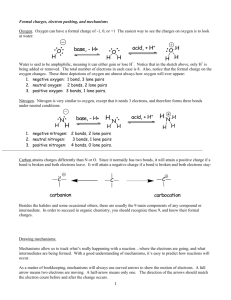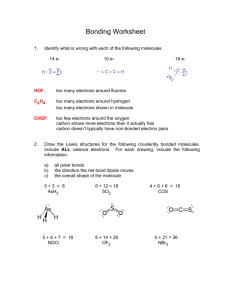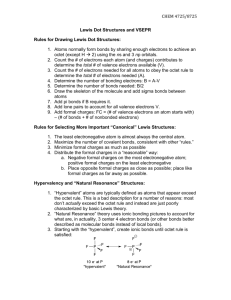Simple Bonding Theory
advertisement
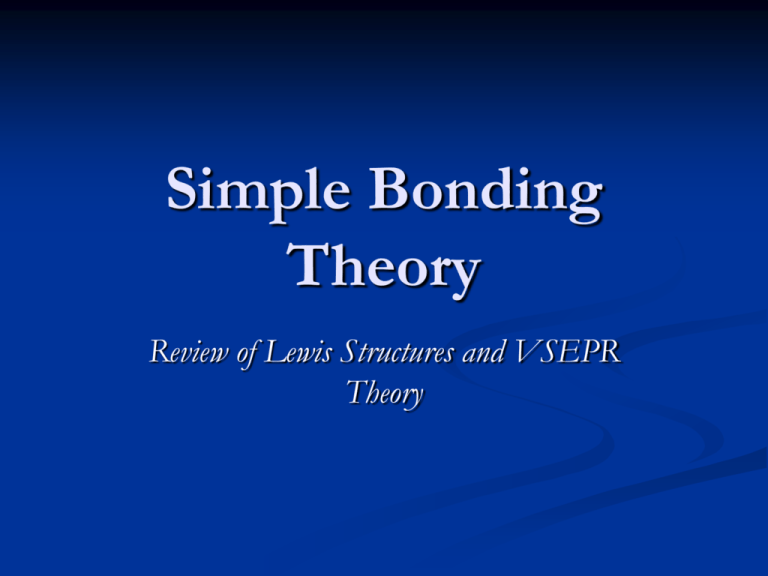
Simple Bonding Theory Review of Lewis Structures and VSEPR Theory Resonance Some molecules may have more than one valid Lewis structure. These structures differ in the placement of multiple bonds. In molecules with resonance, none of the Lewis structures accurately represents the true bonding in the molecule. Resonance The molecule SO2 has two resonance structures: : : : : : : : : : : [ O=S-O: ] ↔ [ :O-S=O] The molecule has two equivalent bonds between sulfur and oxygen. Resonance The sulfur-oxygen bonds are identicallonger than double bonds, and shorter than single bonds. : : : : : : : : [ O=S-O: ] ↔ [ :O-S=O] The true structure of the molecule is in between the two Lewis structures drawn. Resonance The Lewis structure and VSEPR theory correctly predict the shape, polarity and bond angles (≈120o) of the molecule. However, this approach cannot accurately predict the identical nature of the bonds. The sulfur oxygen bonds are equivalent, and somewhat shorter than single bonds, and slightly longer than double bonds. Formal Charges Formal charge is a way to keep track of the electrons in a covalent molecule. The formal charges can also be used to determine if one Lewis structure is more valid than another. Formal Charges The formal charge on an atom is a comparison between the number of valence electrons on each atom and the number of electrons it has in the Lewis structure. Formal Charges Consider the ion SCN-1. There are three valid Lewis structures for the ion. -1 : : : : : : -1 -1 [:S=C=N:] ↔ [:S-C N:] ↔ [:S C-N:] Formal charges can be used to determine the major contributor(s) to the actual structure of the ion. Formal Charges Divide the bonds in half and determine the number of electrons on each atom. -1 : : : : : : -1 -1 [:S=C=N:] ↔ [:S-C N:] ↔ [:S C-N:] 6e 4e 6e 7e 4e 5e 5e 4e 7e Formal Charges Compare the number of electrons in the structure to the number of valence electrons. -1 : : : : : : -1 -1 [:S=C=N:] ↔ [:S-C N:] ↔ [:S C-N:] 6e 4e 6e 6e 4e 5e 7e 4e 5e 6e 4e 5e 5e 4e 7e 6e 4e 5e Formal Charges The net charge is the formal charge on each atom. 0 0 -1 0 -1 +1 0 -2 : : : : : : -1 -1 0 -1 [:S=C=N:] ↔ [:S-C N:] ↔ [:S C-N:] 6e 4e 6e 6e 4e 5e 7e 4e 5e 6e 4e 5e 5e 4e 7e 6e 4e 5e Formal Charges The net charge is the formal charge on each atom. 0 0 -1 0 -1 +1 0 -2 : : : : : : -1 -1 0 -1 [:S=C=N:] ↔ [:S-C N:] ↔ [:S C-N:] The sum of the formal charges must equal the charge on the ion. Formal Charges There are two rules used to determine the most likely Lewis structure(s). 1. Atoms try to achieve formal charges as close to zero as possible. 2. Any negative formal charges should reside on the most electronegative atoms. Formal Charges The third Lewis structure is unlikely, due to the high formal charge on nitrogen. 0 0 -1 0 -1 +1 0 -2 : : : : : : -1 -1 0 -1 [:S=C=N:] ↔ [:S-C N:] ↔ [:S C-N:] Since nitrogen is more electronegative than sulfur, the first structure should be the major contributor. Formal Charges The actual molecule will be somewhere in between the first and second structures. 0 0 -1 0 -1 +1 0 -2 : : : : : : -1 -1 0 -1 [:S=C=N:] ↔ [:S-C N:] ↔ [:S C-N:] The sulfur-carbon bond should be slightly longer than a double bond, and the carbonnitrogen bond should be slightly shorter than a double bond. Formal Charges Some Lewis structures violate the formal charge guidelines (ex. CO and BF3). In either example, if the “octet rule” is to be satisfied, a formal charge of +1 must be placed on the more electronegative element. Formal Charges In the case of BF3, experimental evidence suggests there is some multiple bonding between the boron and the fluorine atoms to create an extended π system. VSEPR Theory/Molecular Shapes Molecules with lone pairs of electrons on the central atom are described as “distorted” from ideal geometry. NH3 has a bond angle of 106.6o H2O has a bond angle of 104.5o Hybridization of Distorted Molecules These molecules can be viewed as having different hybridization in the bonds and lone pairs. Since lone pairs are more diffuse and “bulky”, they will have greater “s” character. Since bonds are more compact and directional, they will have greater “p” character. Hybridization of Distorted Molecules s = p-1 cos θ = s-1 p Determine the hybridization of the bonding and non-bonding orbitals on nitrogen in ammonia. The bond angle is 106.6o. “Expanded” Coordination Elements below period 2 can use d orbitals to make more than 4 bonds. A trigonal bipyramid, with sp3d hybridization, is the common structure for 5 atoms or lone pairs. These molecules are not fully hybridized. The trigonal plane is sp2 hybridized, and the axial positions are a mixture of the pz and dz2 orbitals. 5 Coordinate Complexes In molecules with trigonal planar geometry, not all bond angles and positions are equivalent. If the molecule contains lone pairs of electrons, they will occupy the trigonal plane rather than the axial sites. This will minimize repulsion within the molecule. 5 Coordinate Complexes The lone pair of electrons in the trigonal plane will force the fluorine atoms closer together. F F 101.6o 187o S: F F “Expanded” Coordination Molecules with 6 atoms or lone pairs typically take an octahedral shape, with sp3d2 hybridization. Some complexes with coordination number 6 may be distorted prisms. “Expanded” Coordination Molecules with coordination number of 7 may have a pentagonal bipyramidal shape, and those with a coordination number of 8 may be a square antiprism. Multiple Bonds and Distortion Multiple bonds have an influence on structure similar to that of lone pairs. The diffuse nature of π bonds causes repulsion with lone pairs and bonding pairs of electrons. Electronegativity Electronegativity is a measure of an atoms ability to attract electrons from an atom to which it is bonded. Mulliken Electronegativites Mulliken defined electronegativity as: ½ (electron affinity + ionization energy) This approach yields very high electronegativity values for He and Ne, even though they do not form compounds. Electronegativity Values Electronegativity and Bond Angles Electronegative atoms bonded to a less electronegative central atom tend to draw electron density away from the central atom, thus lowering repulsion. PF3 PCl3 PBr3 97.8o 100.3o 101o Hybridization in Period 3 and Below For central atoms in period 3 or below, hybridization is less common. AsH3 PH3 PF3 PCl3 PBr3 91.8o 93.8o 97.8o 100.3o 101o Steric Number 5 In molecules such as PCl5, the five bonds are not equal in length. Steric Number 5 Any lone pairs preferentially occupy the equatorial positions so as to minimize electron pair repulsion. Steric Number 5 In five-coordinate compounds, the more electronegative (less bulky) atoms occupy the axial positions. Steric Number 5 Methyl groups, considered to be less electronegative than fluorine atoms, occupy the equatorial sites to minimize repulsion between the bonding electron pairs.
